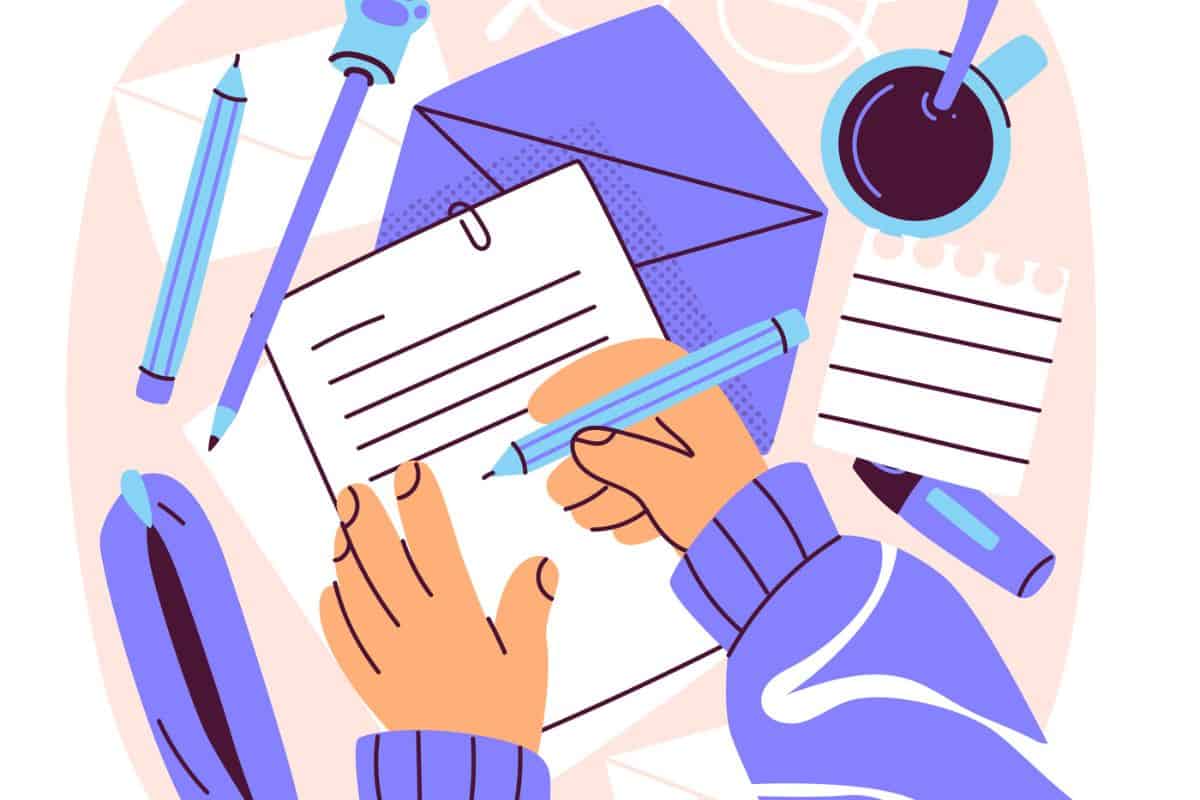“Keep it short and sweet,” some say.
“Make it personal and show your passion,” others swear by.
You’ve scrolled through blogs titled ‘How to Write a Cover Letter That Gets You Hired’ and ‘Avoid These Common Cover Letter Mistakes’.
It’s Confusing. Contradictory. Overwhelming.
But none of these pieces alone will land you the job.
You may wonder, what should you include in a cover letter to make it effective? The answer isn’t about ticking boxes or following tired advice.
It’s about writing a letter that speaks clearly, confidently, and directly to your future employer.
So, what should a good cover letter include? In this blog, we’re cutting through the noise. We’ll give you a smart, proven structure to build your cover letter from scratch.
Let’s get started!
Contact Information at the Top
Your contact info should be the first thing on your cover letter — no exceptions. Here’s the ideal sequence:
- Full name: Use your legal or professional name.
- For example: Jane A. Smith
- Phone number: Use a personal mobile number you actively check. Make sure your voicemail is professional and clear.
- Professional email – Stick to your name-based handle on Gmail or Outlook.
- Good Example: [email protected]
- Bad Example: [email protected] or [email protected]
- LinkedIn profile: Only include this if your profile is updated and tailored to the roles you’re applying for.
- For example: linkedin.com/in/janesmith
- Portfolio link: This is essential for roles in design, writing, marketing, UX, etc.
- Examples:
- janesmithdesign.com (personal site)
- behance.net/janesmith (for designers)
- copyfolio.me/janesmith (for writers)
Hiring managers don’t have time to search for your details. Make it easy. A clean layout also shows you’re organized and professional.
Good Example (Correct Format):
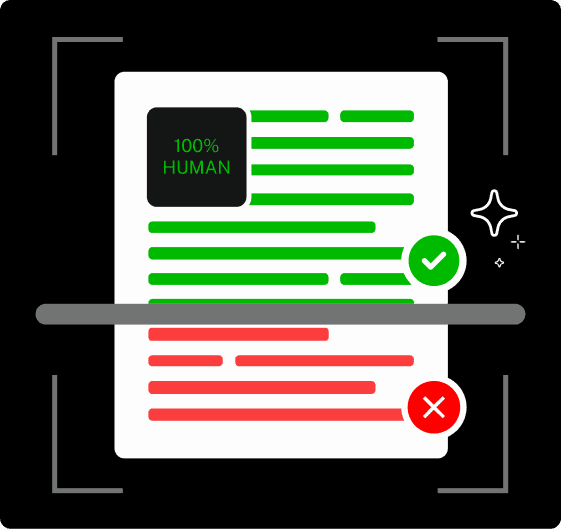

Never Worry About AI Detecting Your Texts Again. Undetectable AI Can Help You:
- Make your AI assisted writing appear human-like.
- Bypass all major AI detection tools with just one click.
- Use AI safely and confidently in school and work.
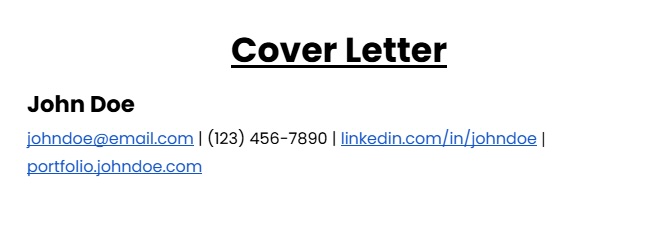
This format is:
✔ Professional
✔ Easy to scan
✔ Uses vertical bars or line breaks
Bad Example (Don’t Do This):

✘ Too wordy
✘ Buries the contact info
✘ Looks amateurish
Formatting tip: You can left-align or center your information — both are acceptable. Just don’t place it in the middle or bottom of your letter.
The Hiring Manager’s Details
When you write the hiring manager’s name at the top of your cover letter, it shows you did your homework. And that matters more than most people think.
So, what should you include in a cover letter to demonstrate your attention to detail?
Start by addressing it to the right person.
Find the hiring manager’s name with these two methods:
- LinkedIn: Type in the company name + the department.
- For example, “Marketing Manager at [Company Name]”).
2 – Company Website: If the above method doesn’t work, go to the company’s website and check the “About” or “Team” page.
Sometimes, you’ll even spot names on the job post itself.
Once you find the name, use the right title:
- If it’s a man: Mr. John Smith
- If it’s a woman: Ms. Jane Smith (use “Ms.” unless you know she prefers “Mrs.”)
- If they’re a doctor or professor: Dr. Alex Lee
Now, what if you can’t find the name at all? At that point, you can use a smart fallback like:
- Hi Hiring Manager
- Hi [Department] Team (e.g., “Hi Marketing Team”)
- Hi [Company Name] Recruitment Team
Never write “Dear” or “To whom it may concern.” It sounds very unprofessional and outdated.
Here is the list of 8 phrases that are killing your cover letter.
As for the company address — it goes at the very top left of the letter. Format it like this:
[Hiring Manager’s Name]
[Company Name]
[Company Street Address]
[City, State, ZIP Code]
Personalized cover letters get way more responses. According to studies, they can improve your chances of getting an interview by up to 50%.
A Strong Opening Paragraph
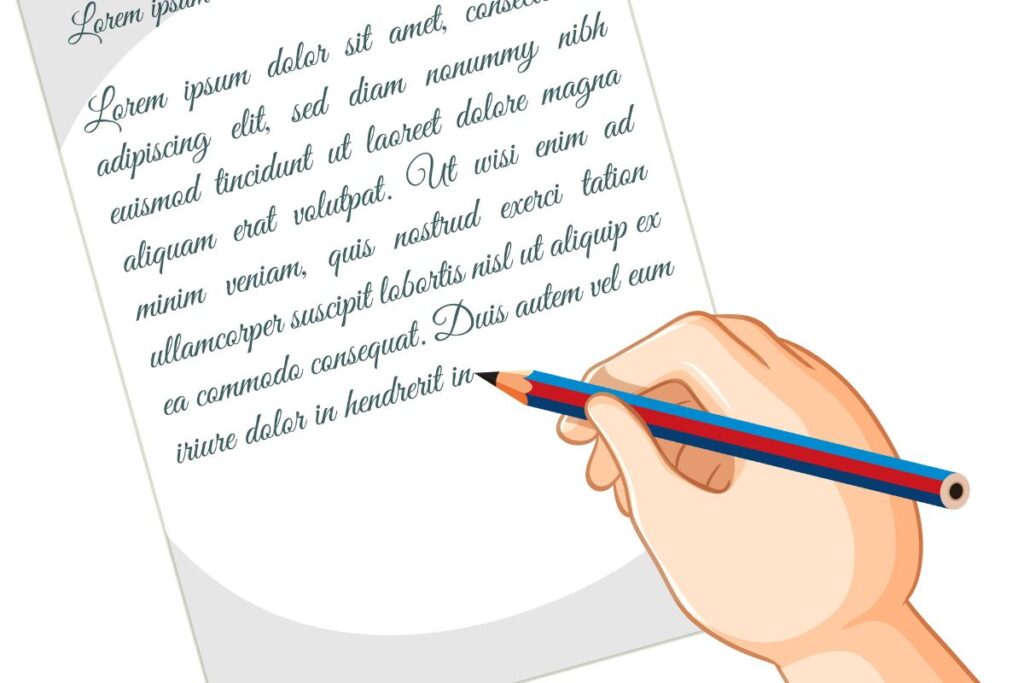
What should the first paragraph of a cover letter include?
The first few lines of your cover letter matter a lot. It’s your one shot to get them to keep reading. So skip the boring stuff like:
“I am writing to apply for the position of…”
They already know which position you’ve applied for. Instead, start something that instantly hooks them and makes them want to learn more about you.
You can try these hooks:
- Company News: For example, I saw your team just launched a new app, and the design is amazing.
- A referral: For example, my former coworker, Alex Torres, spoke highly of your team’s work.
- A Passion Statement: For example, As someone who’s been building websites since middle school, this role instantly grabbed my attention.
Next, mention the job title (and ID, if it’s listed), like this:
“I’m excited to apply for the Junior Web Developer – Job ID 98321 at [Company Name].”
Then say where you found the job:
“I came across the opening on LinkedIn and knew it was a great match.”
Keep this intro to 3–5 sentences max. No more.
Here are a few quick examples for different situations:
1 – Career Change
After 5 years in retail, I’ve discovered my real strength is building customer relationships — especially in fast-moving tech spaces. That’s why I’m excited about the Sales Associate opening (Job ID #2445) at BrightTech.
2 – Recent Grad
As a recent graduate in Computer Science with three internships under my belt, I’m eager to join a team like yours that values fresh ideas and hands-on learning.
3 – Internal Role
After two years supporting clients at the help desk, I’m ready to grow into a new challenge, and the open IT Support Lead role on our team feels like the perfect next step.
Remember, if your first lines sound like everyone else’s, you get skipped like everyone else. Make it personal. Make it real. Keep it short.
Showcase Your Value and Achievements
Now it’s time to show that you’re valuable, with real wins.
Start by thinking of this question:
- What have I done academically and professionally that was distinctive?
Once you have a clear image in mind, here’s a simple way to write this:
👉 Action verb + Task + Measurable result
For example, Increased customer retention by 25% by launching a monthly email series.
This tells them what you did and what changed because of it. That’s what hiring managers care about.
If you’re still not sure what to say, use this STAR method:
- Situation – What was going on?
- Task – What needed to be done?
- Action – What did you do?
- Result – What happened because of it?
For example, Our sales team was falling behind (S). I was asked to improve our follow-up process (T). I built an automated email system (A), which boosted responses by 40% in two months (R).
Now, go back to the job description. See those keywords? Words like “collaboration,” “data analysis,” and “project ownership”? Use them in your cover letter — naturally. It shows you speak their language.
Also, balance your hard skills (like coding, writing, Excel) with soft skills (like communication, problem-solving, leadership). You need both.
If you’re changing careers, focus on transferable skills — things that still apply in the new role.
For example, In retail, I learned how to handle tough customer issues — that same calm, clear thinking is what I’ll bring to this client support role.
Bottom line is that don’t just say you’re a “hard worker.”
Show it with numbers, proof, and real results. That’s what gets attention.
Explain Why You Want This Job at This Company
Before you write your cover letter, take a few minutes to look into the company.
Go to their website. Read their mission. Scan their core values.
Check for recent news — maybe they launched a new product, got a big award, or made a big hire.
These details show you’re not just applying everywhere — you’re choosing them.
Now ask yourself:
- Does this company feel like a place where I’d belong?
If yes, explain why.
Example: I admire how your team puts honesty and customer care first — it’s rare, and it’s something I deeply value in my own work.
Let them know how this role fits your path. Is it your first step into this field? A growth move? A chance to learn from a team you respect?
Example: This role feels like a natural next step for me — a place where I can build on my writing skills while growing into a more strategic content role.
Keep your tone warm but professional. Be excited — but not too casual.
Wrong tone: This company seems chill and fun. I’d love to work with cool people.
Better tone: Your focus on creativity and collaboration is exactly what I’ve been looking for in my next team.
Avoid common traps like saying:
- I need a job.
- I’m excited to grow my career. (Everyone says this.)
- This will be a great opportunity for me. (It’s not just about you.)
Instead, show how your values and skills match what they need. That’s how they know you’re serious.
End With a Call to Action
You’ve told them who you are. You’ve shared what you can do.
Now, don’t just say goodbye — show them you’re ready to take the next step.
This is where you ask for the interview, but you do it in a way that sounds confident, not pushy.
Say something like:
I’d love the chance to talk more about how I can help your team. I’m available for an interview at your earliest convenience.
That’s clear, polite, and action-focused.
This approach shows you’re serious. You’re not just “hoping” they’ll call. You’re making it easy for them to take that step. You’re opening the door.
Avoid weak lines like:
- Hope to hear from you soon.
- Thanks for your time.
Those sound passive — like you’re just waiting around. Instead, wrap your letter with a little energy and purpose. Make them feel like you’re ready to go and excited to start.
Bonus: Formatting and Customization Tips
Before you send your cover letter, let’s make sure it looks as good as it reads.
Make sure you’ve ticked everything off this checklist:
- Is your font easy to read?
- Is your font size set between 10.5 and 12 pt?
- Are your margins set to 1 inch on all sides?
- Did you save your cover letter as a PDF?
- Did you keep it to 1 page?
- Have you broken the content into 3–4 short paragraphs?
- Are you using keywords directly from the job description?
Messy cover letters don’t get read. Clean, professional formatting makes you look sharp.
Plus, ATS systems are used by companies to scan resumes.
They like it neat.
If all of that sounds like a lot, there’s a smarter way to handle it.
Try Undetectable AI’s Cover Letter Generator.
Just drop in your resume and the job posting — the AI does the heavy lifting.
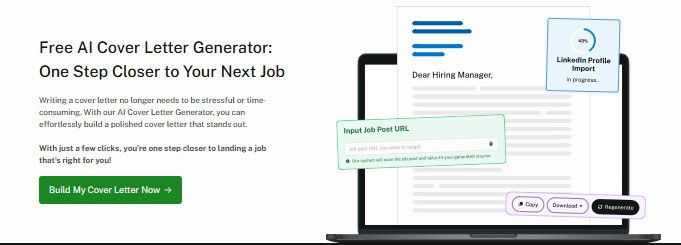
It reads what the company wants, matches it with your skills, and writes a strong, personal letter in seconds.
Why people love it:
- It saves time (just 3 minutes to build a full letter)
- It’s 100% customized for every job
- It’s helped thousands get interviews
- It’s one step closer to the job you want
Instead of second-guessing every word or struggling with formatting, let the AI give you a boost. You still stay in control, just without the headache.
Experience the power of our AI Detector and Humanizer in the widget below!
Conclusion
You’ve heard it all. Play it safe, go bold, keep it brief, pour on the passion.
After reading tip after tip, you’re still wondering — what actually works?
There’s no magic or one-size-fits-all formula. But there is a proven structure to write a cover letter — a way to show up with clarity, confidence, and just enough personality to be memorable.
That’s exactly what we’ve covered in this blog.
Success isn’t about doing everything—it’s about doing what matters.
So if you’re done second-guessing and ready to stand out, let the tools back you up.
Three AI tools can help you in this. Cover Letter Generator, Resume Builder, and Smart Applier are designed to help you move faster, write smarter, and apply with less headache.
Your next opportunity is waiting. Now, make sure they notice you.
